Senedd Cymru – Welsh Parliament
Senedd Cymru (Welsh pronunciation: [ˈsɛnɛð ˈkəm.rɨ]), or the Welsh Parliament in English,[4] (commonly referred to as simply "the Senedd" /ˈsɛnɛð/)[5] is the democratically elected, devolved, unicameral legislature of Wales. It represents the interests of the people of Wales, makes laws for Wales, agrees certain taxes and holds the Welsh Government to account.[6] As a bilingual institution, both Welsh and English are the official languages of its business.[7] From its creation in 1999 until May 2020, the Senedd was known as the National Assembly for Wales (Welsh: Cynulliad Cenedlaethol Cymru).[5]
Senedd Cymru Welsh Parliament | |
|---|---|
| Fifth Senedd | |
| Type | |
| Type | |
| Leadership | |
Chief Executive and Clerk | |
| Structure | |
| Seats | 60 |
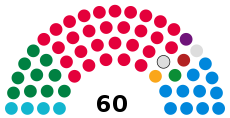 | |
Political groups |
|
| Elections | |
| Additional member system | |
Last election | 5 May 2016 |
Next election | On or before 6 May 2021 |
| Meeting place | |
| Senedd, Cardiff, Wales | |
| Website | |
| senedd | |
The Senedd comprises 60 members who are known as Members of the Senedd (Welsh: Aelodau o'r Senedd),[8] abbreviated as "MS" (Welsh: AS).[9] Since 2011, members are elected for a five-year term of office under an additional member system, in which 40 MSs represent smaller geographical divisions known as "constituencies" and are elected by first-past-the-post voting, and 20 MSs represent five "electoral regions" using the D'Hondt method of proportional representation. Typically, the largest party in the Senedd forms the Welsh Government.
A National Assembly for Wales was created by the Government of Wales Act 1998, upon the result of the 1997 referendum. The National Assembly for Wales had no powers to initiate primary legislation initially. Limited law-making powers were gained through the Government of Wales Act 2006. Its primary law-making powers were enhanced following a Yes vote in the referendum on 3 March 2011, meaning that the UK Parliament or the Secretary of State for Wales were no longer consulted when passing acts of the National Assembly for Wales related to the 20 devolved areas.[10] These powers were further extended by the Wales Act 2014 and Wales Act 2017. The Assembly then renamed itself, effective as of May 2020, to its current name with the Senedd and Elections (Wales) Act 2020. Devolved areas include health, education, economic development, transport, the environment, agriculture, local government and some taxes.
History
Road to devolution
 |
|---|
| This article is part of a series on the politics and government of Wales |
|
|
Wales and the United Kingdom |
|
Law and Justice |
|
Administrative divisions |
|
|
An appointed Council for Wales and Monmouthshire was established in 1949 to "ensure the government is adequately informed of the impact of government activities on the general life of the people of Wales". The council had 27 members nominated by local authorities in Wales, the University of Wales, National Eisteddfod Council and the Welsh Tourist Board. A post of Minister of Welsh Affairs was created in 1951 and the post of Secretary of State for Wales and the Welsh Office were established in 1964 leading to the abolition of the Council for Wales. The establishment of the Welsh Office effectively created the basis for the territorial governance of Wales.[11] The Royal Commission on the Constitution (the Kilbrandon Commission) was set up in 1969 by Harold Wilson's Labour Government to investigate the possibility of devolution for Scotland and Wales.[12] Its recommendations formed the basis of the 1974 White Paper Democracy and Devolution: proposals for Scotland and Wales,[12] which proposed the creation of a Welsh Assembly. However, Welsh voters rejected the proposals in a referendum held in 1979.[12][13] After the 1997 general election, the new Labour Government argued that an Assembly would be more democratically accountable than the Welsh Office. For eleven years prior to 1997 Wales had been represented in the Cabinet of the United Kingdom by a Secretary of State who did not represent a Welsh constituency at Westminster.[14] A referendum was held in Wales on 18 September 1997 in which voters approved the creation of the National Assembly for Wales with a total of 559,419 votes, or 50.3% of the vote.[15]
The following year the Government of Wales Act was passed by the United Kingdom parliament, establishing the Assembly. On 1 July 1999 the powers of the Secretary of State for Wales were transferred to the Assembly and the Welsh Office ceased to exist.[16]
In July 2002, the Welsh Government established an independent commission, with Lord Richard (former leader of the House of Lords) as chair, to review the powers and electoral arrangements of the National Assembly to ensure that it is able to operate in the best interests of the people of Wales.[17] The Richard Commission reported in March 2004. It recommended that the National Assembly should have powers to legislate in certain areas, whilst others would remain the preserve of Westminster.[17] It also recommended changing the electoral system to the single transferable vote (STV) which would produce greater proportionality.[17]
In response, the British government, in its Better Governance for Wales White Paper, published on 15 June 2005, proposed a more permissive law-making system for the Welsh Assembly based on the use of Parliamentary Orders in Council.[18][19] In so doing, the Government rejected many of the cross party Richard Commission's recommendations. This has attracted criticism from opposition parties and others.
Enhanced powers: The Government of Wales Act 2006
The Government of Wales Act 2006 received Royal Assent on 25 July 2006. It conferred on the Assembly legislative powers similar to other devolved legislatures through the ability to pass Assembly Measures concerning matters that are devolved. Requests for further legislative powers made through legislative competence requests were subject to the veto of the Secretary of State for Wales, House of Commons or House of Lords.
The Act reformed the assembly to a parliamentary-type structure, establishing the Welsh Government as an entity separate from, but accountable to the National Assembly. It enables the Assembly to legislate within its devolved fields.
The Act also reforms the Assembly's electoral system. It prevents individuals from standing as candidates in both constituency and regional seats. This aspect of the act was subject to a great deal of criticism, most notably from the Electoral Commission.
The Act was heavily criticised. Plaid Cymru, the Official Opposition in the National Assembly from 1999–2007, attacked it for not delivering a fully-fledged parliament. Many commentators have also criticised the Labour Party's allegedly partisan attempt to alter the electoral system. By preventing regional Members from standing in constituency seats the party has been accused of changing the rules to protect constituency representatives. Labour had 29 members in the Assembly at the time, all of whom held constituency seats.
The changes to the Assembly's powers were commenced on 4 May 2007, after the election.[20]
Following a referendum on 3 March 2011, the Welsh Assembly gained direct law making powers, without the need to consult Westminster.
Reserved powers model: The Wales Act 2017
The Conservative-Liberal coalition government created the Commission on Devolution in Wales (also known as Silk Commission), composed of members nominated by the 4 parties represented in the Welsh Assembly and several leading legal and political experts, to "create a lasting devolution settlement for Wales". Following the first set of recommendations by the Commission, the UK government announced in November 2013 that some borrowing powers are to be devolved to the Assembly along with control of landfill tax and stamp duty. Additionally the Wales Act 2014 provides for a referendum to be held on the Assembly's ability to set a degree of income tax,[21] though there is a proposal for the requirement for a referendum to be removed.
Both the UK and Welsh governments supported the Silk Commission (Part 2) proposal to move to a "reserved powers" model of devolution (similar to that of the Scottish Parliament and the Northern Ireland Assembly) where the UK government would have specific "reserved" powers and the Welsh Assembly would have control of all other matters.[22][23] This replaced the previous model where certain powers were "conferred" and all others were assumed to be powers of the UK national government. Since the passing of the Wales Act 2017, the power model in Wales has been in line with that of Scotland, being a reserved matter model.[24]
The Wales Act 2017, based on the second set of recommendations of the Silk Commission, proposed devolving further areas of government, including some relating to water, marine affairs (ports, harbours, conservation), energy (subsidies, petroleum extraction, construction of smaller energy-generating facilities, etc.), rail franchising and road travel.[25]
Name change
In July 2016, Assembly members unanimously agreed that the name of the Assembly should reflect its constitutional status as a national parliament.[26] The Assembly Commission ran a public consultation on the proposal, which showed that 61% of respondents agreed or strongly agreed that the Assembly should change its name.[27] In 2018, the commission announced its intention to introduce legislation to change the name of the Assembly. Later that year, the Llywydd – the Assembly's presiding officer – wrote to all Assembly Members explaining that the name change proposed in the Bill would be the monolingual name “Senedd”.[28] In 2019, the Senedd and Elections (Wales) Bill, favouring the name "Senedd", was introduced on behalf of the Assembly Commission. Following support of a subsequent amendment to the Bill which favoured a bilingual name for the institution, the Bill was passed by the Assembly on 27 November 2019 and was given Royal Assent on 15 January 2020.[29][30] The Act changed the name of the Assembly to “Senedd Cymru” or “the Welsh Parliament”. Guidance states that the institution will be commonly known as the Senedd in both languages. The name change came into effect on 6 May 2020. Members of the renamed body are known as Members of the Senedd (MSs), or Aelodau o'r Senedd (AS) in Welsh.[31][32]
Buildings
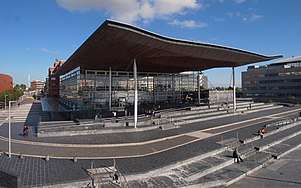
Senedd building
The debating chamber in Cardiff Bay, the Senedd (Senate), was designed by the Richard Rogers Partnership, and built by Taylor Woodrow, with environmental, mechanical, electrical and plumbing design by BDSP Partnership. It uses traditional Welsh materials, such as slate and Welsh oak, in its construction, and the design is based around the concepts of openness and transparency. The timber ceiling and centre funnel, manufactured and installed by BCL Timber Projects (sub-contracted by Taylor Woodrow) is made from Canadian sourced Western Red Cedar.
The Senedd houses the debating chamber (Welsh: Siambr) and Committee Rooms. It was officially opened by Queen Elizabeth II on St David's Day, 1 March 2006.[33]
The Senedd is designed to be environmentally friendly: it uses an Earth Heat Exchange system for heating; rainwater is collected from the roof and used for flushing toilets and cleaning windows, and the roof features a wind cowl which funnels natural light and air into the debating chamber below.[34]
Telecasting

The building houses the debating chamber and committee rooms for the Senedd. Since the Senedd building opened on 1 March 2006, there have been a regular screening of live proceedings from the National Assembly for Wales on S4C2 and also on internet television.[35] Coverage of the S4C2 screenings are on Tuesdays, Wednesdays and Thursdays between 9:00 am 6:00 pm when the Senedd is sitting.[36] In addition, limited screens are shown on the BBC Two Wales programme "am.pm", including First Minister's Questions.[37] Internet television screenings are shown on the National Assembly's own website, which screens approximately 35 hours of content each week in the English and Welsh languages. The service began 15 April 2008.[38] Coverage of events in the Senedd can also be watched on the BBC Democracy Live website.[39][40]
Tŷ Hywel and Pierhead Building

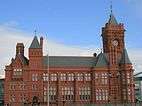
The debating chamber was initially based in Tŷ Hywel, next to the site of the present building. The offices of Members are still in this building which is connected to the Senedd by a skyway. The Senedd Commission is also responsible for the Pierhead Building, which is the location of "The Assembly at the Pierhead" exhibition, and is the Visitor and Education Centre for the Senedd as well as housing a small gift shop. The exhibition, currently still in the process of being updated following the 2016 National Assembly for Wales election, provides visitors with information on who's who, what's happening and how the Senedd works.
North Wales Office
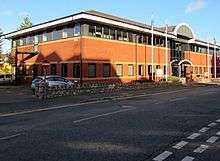
The North Wales Information Centre is located in Prince's Park on Prince's Drive, Colwyn Bay. The office is open to the public to access information about the Senedd. The office is open on weekdays between 9:00 and 17:00.[41]
Officials
Elected officials
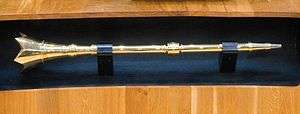
After each election, the Senedd elects one Member of the Senedd to serve as Llywydd (Presiding Officer) of the Senedd, and another to serve as Dirprwy Lywydd (Deputy Presiding Officer). Elin Jones, Plaid Cymru MS, has been Llywydd since 2016, having taken over from Rosemary Butler. The Llywydd also acts as Chair of the Senedd Commission. Both the Llywydd and the Dirprwy Lywydd are expected not to vote.
Permanent officials
The permanent administrative and support staff of the Senedd are employed by the Senedd Commission. They are not civil servants, although they enjoy similar terms and conditions of service to members of the UK Civil Service.
Powers and status
.svg.png)
The Senedd consists of 60 elected members. They use the title Member of the Senedd (MS) or Aelod o'r Senedd (AS).[43] The executive arm of the Senedd, the Welsh Government, has been a Labour administration since its inception in 1999. Currently it is led by First Minister, Mark Drakeford, since December 2018.[44] The government between 2007 and 2011, had been a coalition between Labour, led by First Minister Carwyn Jones and Plaid Cymru, led by Deputy First Minister Ieuan Wyn Jones; since 2016, Labour has been in coalition with the Liberal Democrats and an independent member.[45][46] The executive and civil servants are mainly based in Cardiff's Cathays Park while the MSs, the Senedd Commission and Ministerial support staff are based in Cardiff Bay, where a new £67 million building, the Senedd, has been built.[47][48][49]
One important feature of the National Assembly until 2007 was that there was no legal or constitutional separation of the legislative and executive functions, since it was a single corporate entity. Compared with other parliamentary systems, and arrangements for devolution in other countries of the UK, this was unusual. In practice, however, there was separation of functions, and the terms "Assembly" and "Assembly Parliamentary Service" came into use to distinguish between the two arms. The Government of Wales Act 2006 regularised the separation when it came into effect following the 2007 Assembly Election.
Initially, the Assembly did not have primary legislative or fiscal powers, as these powers were reserved by Westminster. The Assembly did have powers to pass secondary legislation in devolved areas. Sometimes secondary legislation could be used to amend primary legislation, but the scope of this was very limited. For example, the first Government of Wales Act gave the Assembly power to amend primary legislation relating to the merger of certain public bodies. However, most secondary powers were conferred on the executive by primary legislation to give the executive (i.e. Ministers) more powers, and the Assembly had wider legislative powers than appearances might suggest. For example, the Assembly delayed local elections due to be held in 2003 for a year by use of secondary powers, so that they would not clash with Assembly elections. In 2001 the UK parliament used primary legislation to delay for one month local elections in England during the Foot and Mouth Disease epidemic.
The Assembly gained limited primary legislative powers following the 2007 election and the passage of the Government of Wales Act 2006. These laws are known as Assembly Measures and can be enacted in specific fields and matters within the legislative competency of the Assembly. New matters and fields can be devolved by Acts of the UK Parliament or by LCOs approved by Parliament.
Until 2015 the Assembly had no tax-varying powers, however it could influence the rate of Council Tax set by local authorities, which are part-funded by a grant from the Welsh government.[50] It also has some discretion over charges for government services. Notable examples in which this discretion has been used to create significant differences from other areas in the UK are:
- Charges for NHS prescriptions in Wales – these have now been abolished.[51]
- Charges for University Tuition – are different for Welsh resident students studying at Welsh Universities, compared with students from or studying elsewhere in the UK.[52]
- Charging for Residential Care – In Wales there is a flat rate of contribution towards the cost of nursing care (roughly comparable to the highest level of English Contribution) for those who require residential care.[53]
This means in reality that there is a wider definition of "nursing care" than in England and therefore less dependence on means testing in Wales than in England, so that more people are entitled to higher levels of state assistance. These variations in the levels of charges may be viewed as de facto tax varying powers.
This model of more limited legislative powers created in 1999 was partly because Wales has had the same legal system as England since 1536, when it was merged with England. Ireland and Scotland were never merged with England, and so always retained some differences in their legal systems. The Scottish Parliament and the Northern Ireland Assembly both have deeper and wider powers.
The Assembly inherited the powers and budget of the Secretary of State for Wales and most of the functions of the Welsh Office. It has power to vary laws passed by Westminster using secondary legislation.
Following a referendum on 4 March 2011, the Welsh Assembly gained direct law-making powers (without the need to consult Westminster). On 3 July 2012, the Welsh Assembly passed its first Act, the Local Government Byelaws (Wales) Act.[54]
The Wales Act 2014 and Wales Act 2017 devolved the following taxes to the Welsh Assembly:
- Non-domestic rates (business rates) – from 1 April 2015
- Land Transaction Tax (LTT) – from 1 April 2018
- Landfill Disposal Tax (LDT) – from 1 April 2018
- Welsh rate of Income Tax (WRIT) – from 1 April 2019
Devolved areas
The Senedd has the competence to pass bills for Acts of the Senedd in 20 "Subjects" outlined in schedule 7 of the Government of Wales Act 2006.[55]
Those subjects are:
- Agriculture, fisheries, forestry and rural development
- Ancient monuments and historic buildings
- Culture
- Economic development
- Education and training
- Environment
- Fire and rescue services and promotion of fire safety
- Food
- Health and health services
- Highways and transport
- Housing
- Local government
- Public administration
- Social welfare
- Sport and recreation
- Tourism
- Town and country planning
- Water and flood defence
- Welsh language
Members, constituencies, and electoral system
Under mixed-member proportional representation, a type of Additional Member System,[56][57] forty of the MSs are elected from single-member constituencies on a plurality voting system (or first past the post) basis, the constituencies being equivalent to those used for the House of Commons and twenty MSs are elected from regional closed lists using an alternative party vote.[58] There are five regions: Mid and West Wales, North Wales, South Wales Central, South Wales East and South Wales West (these are the same as the pre 1999 European Parliament constituencies for Wales), each of which returns four members.[58] The additional members produce a degree of proportionality within each region.[58] Whereas voters can choose any regional party list irrespective of their party vote in the constituency election, list MSs are not elected independently of the constituency element; rather, elected constituency MSs are deemed to be pre-elected list representatives for the purposes of calculating remainders in the D'Hondt method.[58] Overall proportionality is limited by the low proportion of list members (33% of the Senedd compared with 43% in the Scottish Parliament and 50% in the German Bundestag) and the regionalisation of the list element.[59] Consequently, the Senedd as a whole has a greater degree of proportionality (based on proportions in the list elections) than the plurality voting system used for British parliamentary elections, but still deviates somewhat from proportionality.[59] The single transferable vote system had been considered for the Senedd by the Labour Party as early as 1995–96, but according to the evidence given to the Richard Commission by Ron Davies, a former Welsh Secretary,
Had we done that of course we would have had to have had a Boundary Commission and that process would have taken forever and a day and that would have frustrated our overall political timetable. So we had to settle on the existing constituency arrangements, parliamentary constituencies and European Constituencies.[59]
In April 2020 the Senedd became the first legislature in the UK to meet over the internet. Due to the consequences of the COVID-19 pandemic, it held First Minister's Questions using Zoom videotelephony software and the session was subsequently broadcast by Senedd.tv.[60]
Elections
There have been five elections to the Assembly, in 1999, 2003, 2007, 2011 and 2016. The 2016 election was delayed from 2015 as the UK general election was held in 2015.[61][62]
The next Senedd election is due to be held on Thursday 6 May 2021.
Summary
| Assembly/Parliament | Year | Turnout | Seats | Governments | |||||
|---|---|---|---|---|---|---|---|---|---|
| Welsh Labour | Plaid Cymru | Conser- vative | Lib Dems | UKIP | Others | ||||
| 1997 | 50% | Devolution referendum | |||||||
| 1st | 1999 | 46% | 28 | 17 | 9 | 6 | – | – | Michael (Labour minority) Interim Morgan (Labour minority) Morgan I (Labour – LD) |
| 2nd | 2003 | 38% | 30 | 12 | 11 | 6 | 0 | 1 (JMIP) | Morgan II (Labour minority) |
| 3rd | 2007 | 44% | 26 | 15 | 12 | 6 | 0 | 1 (BGPVG.) | Morgan III (Labour minority) Morgan IV (Labour – Plaid) Jones I (Labour – Plaid) |
| 2011 | 36% | Devolution referendum | |||||||
| 4th | 2011 | 42% | 30 | 11 | 14 | 5 | 0 | – | Jones II (Labour minority) |
| 5th | 2016 | 45% | 29 | 12 | 11 | 1 | 7 | – | Jones III (Labour–LD majority[lower-alpha 2]) Drakeford (Labour–LD majority[lower-alpha 2]) |
Last election
| 2016 Welsh Assembly election | ||||||||||||||||
|---|---|---|---|---|---|---|---|---|---|---|---|---|---|---|---|---|
| Parties | Additional member system | Total seats | ||||||||||||||
| Constituency | Region | |||||||||||||||
| Votes | % | +/− | Seats | +/− | Votes | % | +/− | Seats | +/− | Total | +/− | % | ||||
| Labour | 353,866 | 34.7 | −7.6 | 27 | −1 | 319,196 | 31.5 | −5.4 | 2 | 0 | 29 | −1 | 48.3 | |||
| Plaid Cymru | 209,376 | 20.5 | +1.3 | 6 | +1 | 211,548 | 20.8 | +3.0 | 6 | 0 | 12 | +1 | 20.0 | |||
| Conservative | 215,597 | 21.1 | −3.9 | 6 | 0 | 190,846 | 18.8 | −3.7 | 5 | −3 | 11 | -3 | 18.3 | |||
| UKIP | 127,038 | 12.5 | +12.5 | 0 | 0 | 132,138 | 13.0 | +8.5 | 7 | +7 | 7 | +7 | 11.7 | |||
| Liberal Democrats | 78,165 | 7.7 | −2.9 | 1 | 0 | 65,504 | 6.5 | −1.6 | 0 | −4 | 1 | -4 | 1.7 | |||
| Green | 25,202 | 2.5 | +2.3 | 0 | 0 | 30,211 | 3.0 | −0.5 | 0 | 0 | 0 | 0 | 0.0 | |||
| Independent | 7,032 | 0.7 | −0.6 | 0 | 0 | 1,577 | 0.2 | 0 | 0 | 0 | 0 | 0 | 0.0 | |||
| Abolish the Welsh Assembly | 44,286 | 4.4 | N/A | 0 | 0 | 0 | 0 | 0.0 | ||||||||
| Monster Raving Loony | 5,743 | 0.6 | +0.4 | 0 | 0 | 0 | 0 | 0.0 | ||||||||
| Trade Unionists and Socialists Against Cuts | 2,040 | 0.2 | +0.0 | 0 | 0 | 0 | 0 | 0.0 | ||||||||
| Welsh Communist Party | 2,452 | 0.2 | +0.0 | 0 | 0 | 0 | 0 | 0.0 | ||||||||
| Others | 3,107 | 0.3 | −1.1 | 0 | 0 | 9,202 | 0.9 | −5.0 | 0 | 0 | 0 | 0 | 0.0 | |||
Current composition
| Party | After the 2016 election |
Current | |
|---|---|---|---|
| Labour | 29 | 29 | |
| Plaid Cymru | 12 | 10 | |
| Conservative | 11 | 11 | |
| UK Independence Party | 7 | 1 | |
| Liberal Democrats | 1 | 1 | |
| Brexit Party | N/A | 4 | |
| AWAP | 0 | 1 | |
| Welsh National Party | N/A | 1 | |
| Independents | 0 | 2[lower-alpha 1] | |
| Jones/Drakeford governments | 30 | 31[lower-alpha 2] | |
Government formation
The May 2016 election saw the biggest ever change in the Assembly's composition. Labour dropped from 30 to 29 seats, and Plaid Cymru moved from 11 to 12 seats. The Conservatives lost 3 seats, moving from 14 seats to 11, while the Liberal Democrats dropped from 5 to 1 seat. UKIP, who had not previously had representation, gained seven AMs.
In the initial ballot for First Minister, Plaid Cymru's Leanne Wood and Labour's Carwyn Jones each gained 29 votes; a week of talks were then held. A document was produced after Plaid Cymru–Labour talks entitled "Moving Wales Forward", which detailed policy concessions in exchange for allowing Carwyn Jones to become First Minister. Labour appointed Kirsty Williams as Education Secretary, so that the minority government was a coalition between Welsh Labour and the Welsh Liberal Democrats. Plaid Cymru, the Conservatives and UKIP formed opposition groups.
Changes since the election
After four months in the Assembly, North Wales AM Nathan Gill left the UKIP group to sit as an independent, citing much infighting and distractions.[63] He remained a member of the party and its leader in Wales, until Neil Hamilton was made Wales leader in September 2016.[64]
Dafydd Elis-Thomas quit the Plaid Cymru group on 14 October 2016. As a result of the defection, Leanne Wood lost the title of leader of the opposition. Two months later, he pledged to back the Welsh Labour-led Government, giving the new government an overall majority in the Welsh Assembly.[65][66]
Neil McEvoy was suspended by the Plaid Cymru group after a tribunal found him guilty of bullying in his other role as a councillor for Cardiff. He was later expelled from Plaid Cymru.[67]
Mark Reckless quit the UKIP group in April 2017. He then sat as a Conservative AM, but without being an official member of the Conservative Party.[68]
Carl Sargeant was suspended from Welsh Labour following allegations about his personal conduct. On 7 November 2017, he was found dead.[69] A by-election was held in his former constituency of Alyn and Deeside on 6 February 2018 to choose a successor; this was won by the Labour candidate, his son, Jack.[70]
On 27 December 2017 it was announced that Nathan Gill had resigned as an AM.[71] As 3rd on UKIP's list for the North Wales region, Mandy Jones was sworn in as a Member on 29 December 2017.[72] On 9 January UKIP Wales announced that she would not be joining the UKIP group in the Assembly, due to employing members of other parties in her office.[73]
Helen Mary Jones replaced Simon Thomas as a Member in August 2018.[74]
Caroline Jones resigned as a member of UKIP and from UKIP's group on 12 September 2018.[75]
Jenny Rathbone was suspended from Labour on 20 November 2018 following the publishing of a recording in which she claimed Jewish people's security fears could be "in their own heads" and that hostile behaviour towards Jewish people was driven by the behaviour of the Israeli government. Jewish leaders had described the remarks, made at a meeting in her constituency a year ago, as "inexcusable".[76] She was later re-admitted.[77]
Steffan Lewis died of bowel cancer on 11 January 2019 and was replaced by Delyth Jewell.[78]
Michelle Brown left the UKIP group in March 2019, to sit as an independent.[79]
Mark Reckless left the Conservative group in May 2019, citing failure to deliver Brexit as a reason.[80] He later joined the Brexit Party along with David Rowlands, Caroline Jones and Mandy Jones.[81]
Gareth Bennett left the UKIP group in November 2019 to sit as an independent, leaving Neil Hamilton as the party's last remaining member on the Assembly.[82]
Nick Ramsay was arrested on 1 January 2020 and suspended from the Conservative group the following day. [83] He was later readmitted.
Neil McEvoy formed his own party, The Welsh National Party, on 15 January 2020.[84]
Conservative MS Mohammad Asghar died on 16 June 2020 and was replaced by Laura Ann Jones.[85]
Gareth Bennett joined the Abolish the Welsh Assembly Party on 24 June 2020.[86]
See also
| Wikimedia Commons has media related to National Assembly for Wales. |
- Contemporary Welsh Law
- Act of the Senedd
- List of Welsh Assembly by-elections
- London Assembly
- Member of the Senedd
- List of female Members of the Senedd
- 1999 National Assembly for Wales election
- 2003 National Assembly for Wales election
- 2007 National Assembly for Wales election
- 2011 National Assembly for Wales election
- 2016 National Assembly for Wales election
- 2021 Senedd election
- Northern Ireland Assembly
- Senedd constituencies and electoral regions
- Scottish Parliament
- Parliament of the United Kingdom
- United Kingdom budget
- Wales-only laws
Notes
- The independent member is Dafydd Elis-Thomas. Elis-Thomas is also a Deputy Minister for the Welsh Government.
- The government reached a 31-seat majority following the defection of Dafydd Elis-Thomas, elected for Plaid Cymru.
References
- "Welsh Government – Ministers". 3 November 2017 – via www.gov.wales.
- "Siambr Seating Plan". National Assembly for Wales.
- "Assembly members join forces with Farage". 15 May 2019. Retrieved 15 May 2019 – via www.bbc.co.uk.
- "Senedd Cymru and Welsh Parliament names become law". senedd.wales. 6 May 2020. Retrieved 11 May 2020.
- "Name Change Information". senedd.wales. Retrieved 10 May 2020.
- "What is the role of the Senedd?". Retrieved 13 May 2020.
- Senedd Cymru – Welsh Parliament. National Assembly for Wales (Official Languages) Act 2012 as amended (see also enacted form), from legislation.gov.uk.
- "Senedd and Elections (Wales) Act 2020". Legislation.gov.uk. 5 March 2020. Retrieved 11 May 2020.
- "Senedd and Elections (Wales) Bill" (PDF). senedd.wales.
- "Wales says Yes in referendum vote". BBC News. 4 March 2011.
- The road to the Welsh Assembly from BBC Wales History website. Retrieved 23 August 2006.
- Devolution in the UK: Department for Constitutional Affairs. UK State website. Retrieved 9 July 2005.
- The 1979 Referendums: BBC website. Retrieved 9 July 2006.
- Evidence to Richards Commission Archived 28 September 2007 at the Wayback Machine of Cllr Russell Goodway. 10 July 2003. Retrieved 9 July 2006.
- Politics 97 by Joshua Rozenberg: BBC website. Retrieved 9 July 2006.
- Key Events in the Development of the National Assembly for Wales: First Assembly, 1999–2003 (PDF), National Assembly for Wales, p. 15, retrieved 1 July 2019
- The Richard Commission. Archived Richard Commission Website, includes copy of Commission report. Archived 10 April 2010.
- Better Governance for Wales White Paper, Archived February 2006. Presented to Parliament by the Secretary of State for Wales in June 2005. Downloadable PDF. Retrieved 9 December 2005.
- Electoral Reform for Wales Archived 8 December 2004 at the Wayback Machine. Electoral Reform Society response to rejection of Richard Commission recommendations. Retrieved 9 December 2005.
- Assembly powers bill becomes law: BBC News. 25 July 2006. Retrieved 15 September 2006.
- "Wales offered tax raising powers". BBC News. 1 November 2013.
- Wales Office (UK Government). "Government Response to the Welsh Affairs Committee Report on Pre-legislation Scrutiny of the Wales Bill" (PDF).
- Welsh Government. "Draft Government and Laws Bill in Wales".
- "Wales Act 2017". legislation.gov.uk.
- "Wales Bill 2016" (PDF).
- seneddresearch (5 March 2019). "The Senedd and Elections (Wales) Bill". IN BRIEF. Retrieved 27 May 2020.
- "National Assembly to be renamed Welsh Parliament under new law". ITV News. Retrieved 27 May 2020.
- Jones, Elin (2018). "Letter from the Llywydd to all Assembly Members" (PDF). Senedd Cymru.
- Ifan, Mared (30 September 2019). "National Assembly set for new bilingual name". BBC News. Retrieved 27 May 2020.
- "Historic Act enables voting for 16 and 17 year olds – renames Assembly to "Welsh Parliament"". Wrexham.com. 16 January 2020.
- "Name Change Consultation". assembly.wales.
- "Votes at 16 plan for 2021 Senedd election". 12 February 2019. Retrieved 15 May 2019 – via www.bbc.co.uk.
- The New National Assembly for Wales Senedd opened on St David’s Day Archived 11 March 2007 at the Wayback Machine National Assembly for Wales, Public Information page. Retrieved 4 May 2006
- "National Assembly for Wales – the Senedd, Cardiff Bay, docks and Tiger Bay, Cardiff, south Wales". Urban75.org. Retrieved 21 May 2011.
- "Access to our Information, Proceedings and Buildings". National Assembly for Wales. Retrieved 7 June 2009.
- "Web TV will stream proceedings National Assembly for Wales to help e-democracy". Public Technology Ltd. Retrieved 7 June 2009.
- "am.pm". BBC. Retrieved 7 June 2009.
- "Assembly to launch enhanced E-democracy services". National Assembly for Wales. Retrieved 7 June 2009.
- "Index". BBC News. 31 May 2011.
-
www.senedd.tv - "North Wales Office". Welsh Parliament.
- "First Welsh law's royal approval". BBC News. 9 July 2008. Retrieved 21 May 2011.
- The National Assembly for Wales, Civil rights – In Wales, Advice guide, Citizens Advice Bureau. Retrieved 13 July 2006.
- "Carwyn Jones unveils three new faces in Welsh cabinet". BBC News website. BBC. 13 May 2011. Retrieved 14 May 2011.
- "Welsh Assembly Government – Cabinet Members". Welsh Assembly Government website. Welsh Assembly Government. 2007. Retrieved 16 April 2009.
- "Crucial extracts from the One Wales Labour/Plaid Cymru coalition document". Martin Shipton, Western Mail. WalesOnline. 28 June 2007. Retrieved 16 April 2009.
- National Assembly for Wales and Welsh Assembly in Guide to government: Devolved and local government, Direct.gov.uk, UK state website. Retrieved 13 July 2006.
- Assembly Building Archived 8 January 2007 at the Wayback Machine: Welsh Assembly website. Retrieved 13 July 2006.
- New assembly building opens doors: BBC News, 1 March 2006. Retrieved 13 July 2006.
- "Tories call for Welsh government to freeze council tax". BBC News. 3 October 2011. Retrieved 23 September 2012.
- Q and A: Welsh prescription prices: BBC News, 1 October 2004. Retrieved 31 July 2006.
- Q&A: Welsh top-up fees: BBC News, 22 June 2005. Retrieved 31 July 2006.
- "NHS Continuing Care – Commons Health Select Committee" Archived 25 September 2006 at the Wayback Machine, News and Views – NHFA. Retrieved 10 November 2006.
- AMs applaud as Assembly passes first Bill... on byelaws. Wales Online (3 July 2012). Retrieved on 24 August 2013.
- "Government of Wales Act 2006". Legislation.gov.uk. Retrieved 21 May 2011.
- "Mixed-Member Proportional Voting" in Proportional representation voting systems, Types of Voting Systems: PR Library created by Professor Douglas J. Amy, Department of Politics, Mount Holyoke College. Retrieved 8 July 2006.
- Electing the Welsh Assembly Archived 23 March 2005 at the Wayback Machine: Electoral Reform Society, information regarding Additional member system elections. Retrieved 9 December 2005.
- The Welsh electoral system: BBC News, 7 June 1999. Retrieved 7 July 2006.
- Chapter 12: "The Electoral Arrangements" of the Report of the Richard Commission: Commission on the Powers and Electoral Arrangements of the National Assembly for Wales. PDF document. Retrieved 8 July 2006.
- "Welsh Assembly meets remotely for the first time". www.expressandstar.com. Retrieved 5 April 2020.
- "2015 Welsh assembly election delayed, says Carwyn Jones". BBC Online. 16 March 2011. Retrieved 16 March 2011.
- Fixed-term Parliaments Act 2011 section 5
- "UKIP MEP Nathan Gill told to quit as successor is 'ready'". BBC News. 29 July 2016. Retrieved 28 October 2016.
- "Nathan Gill leaves UKIP assembly group to sit as independent". BBC News. 17 August 2016. Retrieved 28 October 2016.
- "Plaid Cymru AM Lord Dafydd Elis-Thomas quits party". BBC News. 14 October 2016. Retrieved 22 October 2016.
- "Elis-Thomas pledges to back Labour Welsh Government". BBC News. 19 December 2016.
- "McEvoy thrown out of Plaid for 18 months". 19 March 2018. Retrieved 7 February 2019 – via www.bbc.co.uk.
- Walker, Peter; Mason, Rowena (6 April 2017). "Mark Reckless quits Ukip to join Conservative group in Welsh assembly". the Guardian.
- Shipton, Martin (7 November 2017). "Former Welsh Govt Minister Carl Sargeant has been found dead". Wales Online.
- Proctor, Kate (7 February 2018). "Jack Sargeant follows his father into Welsh Assembly after by-election win". London Evening Standard. Retrieved 9 March 2018.
- "Nathan Gill resigns from assembly". 27 December 2017 – via www.bbc.co.uk.
- "New UKIP AM Mandy Jones sworn in". 29 December 2017 – via www.bbc.com.
- "UKIP Wales say New North Wales Regional AM 'will not be joining UKIP group'". 9 January 2018.
- "Helen Mary Jones returns as Plaid AM". 2 August 2018 – via www.bbc.co.uk.
- Deans, David (12 September 2018). "UKIP AM quits party over 'far-right move'". Retrieved 7 February 2019 – via www.bbc.co.uk.
- "Labour AM suspended over Jewish remarks". 20 November 2018. Retrieved 7 February 2019 – via www.bbc.co.uk.
- "Jewish remarks Labour AM re-admitted". 9 January 2019 – via www.bbc.co.uk.
- "New AM Delyth Jewell following death of Steffan Lewis". BBC News. 16 January 2019. Retrieved 22 January 2019.
- Deans, David (26 March 2019). "Another UKIP AM resigns from party". Retrieved 15 May 2019 – via www.bbc.co.uk.
- "Mark Reckless leaves Tories in Cardiff Bay". 14 May 2019. Retrieved 15 May 2019 – via www.bbc.co.uk.
- Mosalski, Ruth (10 July 2019). "We asked the Brexit Party's AMs what they stand for - only one would tell us". walesonline.
- "UKIP down to one AM, after Bennett quits the party". 7 November 2019. Retrieved 10 November 2019.
- "Welsh Tory Nick Ramsay suspended from party after 'police incident'". 2 January 2020. Retrieved 2 January 2020.
- Hayward, Will (6 May 2020). "Neil McEvoy loses fight to call his new party the Welsh National Party". walesonline.
- "New Conservative Senedd member is confirmed". 2 July 2020 – via www.bbc.co.uk.
- "A Member of the Senedd has joined the Abolish the Assembly party". Wales Online. 24 June 2020. Retrieved 24 June 2020.
